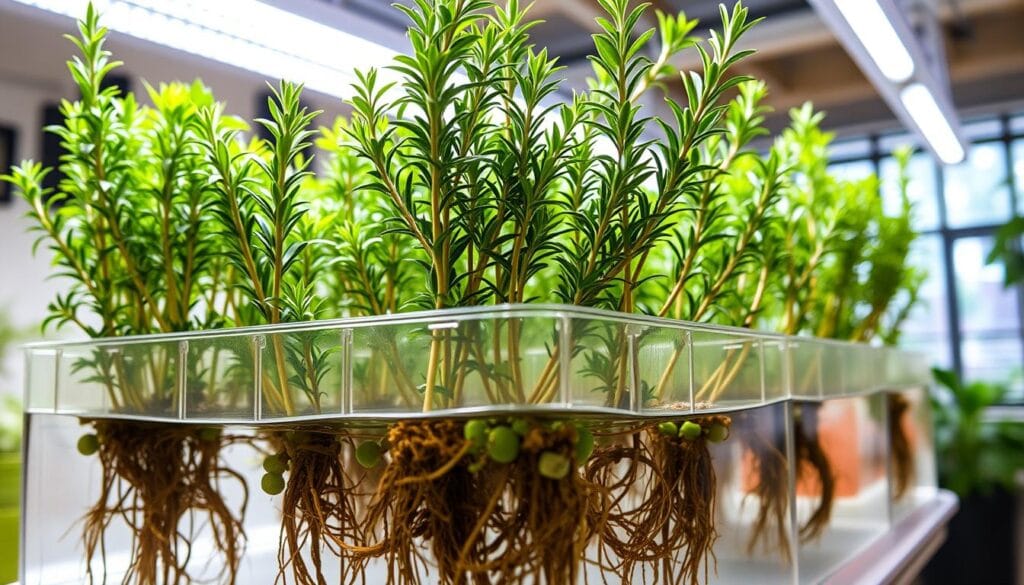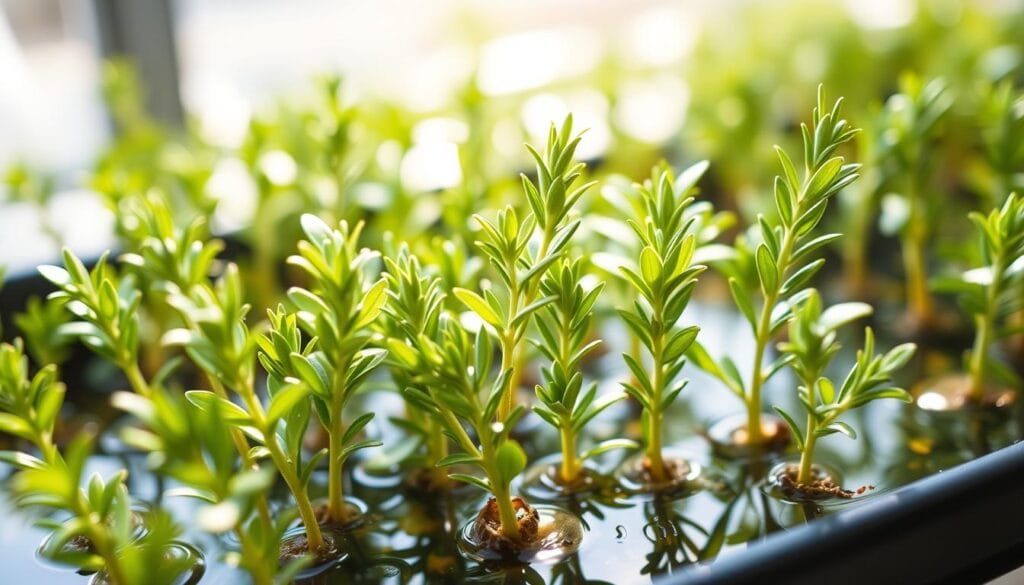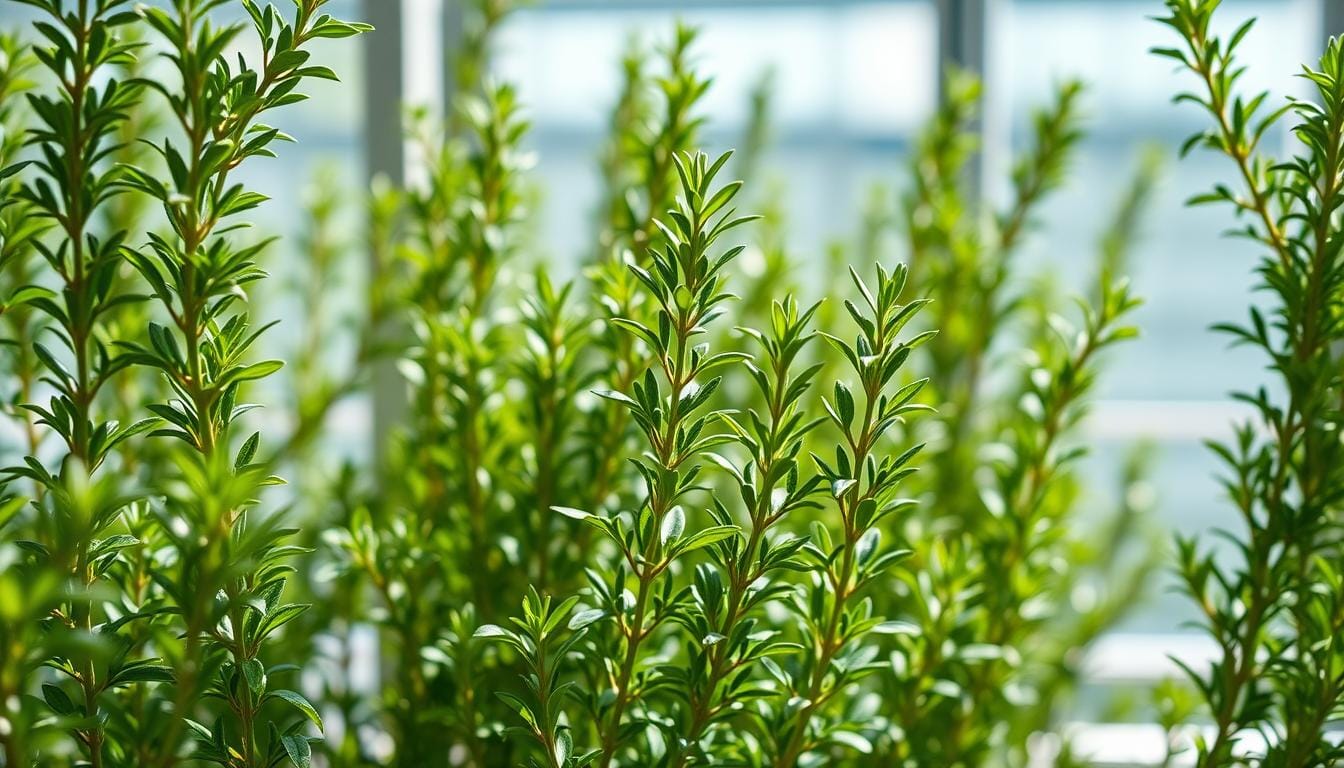As a gardener, I love seeing plants grow, especially rosemary. With the right setup, rosemary sprouting in hydroponics can be a game-changer for indoor gardening. We’ll share tips to make rosemary grow faster so you can enjoy your indoor garden sooner.
Key Takeaways
- Rosemary seeds typically take 15-30 days to germinate in ideal conditions.
- Hydroponic systems offer better control over temperature, humidity, and lighting to speed up germination.
- Proper seed preparation, nutrient management, and water quality monitoring are crucial for successful rosemary sprouting.
- Understanding rosemary’s unique growing requirements, such as its need for well-draining soil and ample sunlight, is key to a thriving hydroponic setup.
- Transitioning sprouted rosemary seedlings to the growing phase requires careful attention to root development and transfer timing.
Understanding Rosemary as a Hydroponic Crop
Rosemary (Rosmarinus officinalis) is a hardy, fragrant herb from the Mediterranean region. It loves well-drained, sandy soils and full sun. Growing rosemary hydroponically brings many benefits, like faster growth and water savings.
Origins and Characteristics of Rosemary
Rosemary originates from the Mediterranean region, thriving in warm, dry climates. It needs at least 6 to 8 hours of bright, direct sunlight daily and ideal temperature conditions ranging from 65°F to 75°F (18°C to 24°C). It prefers dry conditions, avoiding overly humid environments.
Benefits of Growing Rosemary Hydroponically
Hydroponic systems are great for rosemary. They consume up to 90% less water than conventional soil gardening methods, making them an incredibly water-efficient option for growing plants. Plus, some herbs mature in half the time in hydroponics, making rosemary perfect for year-round, space-efficient indoor cultivation.
Common Challenges in Hydroponic Rosemary Cultivation
Hydroponic rosemary has its challenges. Keys are keeping the right nutrient balance and preventing root rot. Managing humidity levels and pruning are also crucial. Choose dwarf varieties and ensure good air circulation for healthy growth.
“Rosemary is known for its antioxidant properties and benefits in reducing inflammation, improving digestion and memory, making it an excellent choice for marinades, roasted vegetables, and infused oils.”
Essential Hydroponic Setup Requirements for Rosemary
Using a hydroponic system helps rosemary grow better and produce more. To ensure your hydroponic setup works well for this herb, consider a few important things.
The growing medium is very important. Rosemary likes a medium that drains well and lets in air, like perlite, vermiculite, or coco coir. These materials support the roots and help them get enough oxygen, which is key for healthy growth.
- Perlite: A lightweight, porous volcanic rock that enhances drainage and aeration.
- Vermiculite: A mineral-based growing medium that helps retain moisture and nutrients.
- Coco coir: A renewable, sustainable alternative derived from coconut husks, known for its excellent water-holding capacity and air circulation properties.
The hydroponic system also needs good drainage and aeration. This means having a reservoir for the nutrient solution, a pump to move the solution, and an airstone for root oxygenation.
| Component | Purpose |
|---|---|
| Reservoir | Holds the nutrient-rich water solution |
| Pump | Circulates the nutrient solution through the system |
| Air Stone | Introduces oxygen into the nutrient solution, promoting healthy root growth |
Keeping the right pH levels is also key for rosemary’s growth. The best pH range for hydroponic rosemary is between 5.5 and 6.5, which helps the plant absorb nutrients like potassium and calcium.
Lastly, your hydroponic rosemary setup needs a container 12 inches in diameter. This size is big enough for the herb’s strong root system and helps it grow well. Following these guidelines, you can make a great hydroponic space for your rosemary to flourish.
Optimal Growing Conditions for Rosemary Sprouting in Hydroponics
To grow rosemary well in hydroponics, you need the right conditions. This includes the right temperature, light, and nutrients. Knowing these helps your rosemary grow fast and strong.
Temperature and Humidity Control
Rosemary likes temperatures between 65°F and 75°F (18°C to 24°C). The best is around 70°F (21°C) when it’s sprouting. Keeping the temperature steady helps roots and leaves grow well.
Also, keep humidity between 40% and 60%. This prevents leaves from turning color or getting sick from fungi.
Light Requirements and Duration
Rosemary needs lots of light to grow well. Give it 6 to 8 hours of direct sunlight every day. If indoors, use grow lights 6 to 12 inches away. Turn them on for 12 to 16 hours a day.
Good lighting gives rosemary the energy it needs to sprout fast and strong.
pH and Nutrient Solution Specifications
To maintain healthy rosemary, ensure the pH level is between 5.5 and 6.5, and the electrical conductivity (EC) stays within the range of 1.0 to 1.6 mS/cm. Use a balanced nutrient solution. Increase potassium and calcium as the plants bloom.
By controlling the hydroponic environment, rosemary growth factors, and indoor herb cultivation, you can make your rosemary sprout fast and strong in hydroponics.
Selecting the Right Hydroponic System for Rosemary
There are many systems for growing rosemary hydroponically. The ebb and flow system is great for this herb because it provides good oxygen and nutrients. The deep water culture (DWC) system also works well, but you must watch out for root rot.
The nutrient film technique (NFT) is good for small rosemary plants. Wick systems are simple to set up and maintain, but they may not supply sufficient nutrients for larger plants. When picking a system, consider space, upkeep, and how much you can grow.
| Hydroponic System | Suitability for Rosemary | Pros | Cons |
|---|---|---|---|
| Ebb and Flow | Excellent |
|
|
| Deep Water Culture (DWC) | Effective |
|
|
| Nutrient Film Technique (NFT) | Good |
|
|
| Wick System | Limited |
|
|
The right hydroponic system for rosemary depends on your needs, budget, and growing space. It’s key to weigh the good and bad of each system for a healthy rosemary crop.
Seed Preparation and Germination Techniques
Getting rosemary seeds ready and knowing when they will germinate is key to growing them well in hydroponics. You can grow strong, healthy rosemary plants by using the right seed pre-treatment and carefully watching the germination.
Pre-treatment Methods
Stratifying your rosemary seeds can boost germination rates. Place the seeds in a moist medium, like a damp paper towel, in a plastic bag. Then, keep the bag in the fridge for 3-4 weeks. This cold treatment mimics the natural climate of rosemary’s home, helping the seeds wake up and grow.
Seed scarification is another helpful step. Gently rub the seeds with sandpaper or emery cloth to scratch the outer layer. This makes it easier for water and air to get inside, helping the seeds germinate better.
Germination Timeline Expectations
Germinating rosemary seeds takes time, so be patient. It can take 15-30 days, sometimes up to 6 weeks. Ensure the seeds remain moist and maintain a temperature of around 70°F (21°C) for optimal germination. A humidity dome can help keep the moisture in during this important time.
Knowing how to prepare and germinate rosemary seeds is crucial for success in hydroponics. It sets the stage for growing healthy, vibrant plants.
Managing Nutrient Solutions for Healthy Growth
Manage the nutrient solution to ensure your hydroponic rosemary grows well. Use a balanced hydroponic fertilizer made for herbs or Mediterranean plants. Keep the electrical conductivity (EC) levels between 1.0 and 1.6 mS/cm. As your rosemary grows, you can slowly increase the EC levels.
It’s also important to monitor and adjust the solution’s pH. For rosemary, try to keep it between 5.5 and 6.5. This plant likes slightly acidic conditions. It also needs more potassium and calcium, especially when it’s flowering.
- Change the nutrient solution weekly or when EC levels drop significantly.
- Flush the entire system with plain water every 2-3 weeks to prevent salt buildup and maintain optimal nutrient balance.
| Nutrient | Recommended Concentration (ppm) |
|---|---|
| Nitrogen (N) | 150-200 |
| Phosphorus (P) | 31-50 |
| Potassium (K) | 210-280 |
| Calcium (Ca) | 150-200 |
| Magnesium (Mg) | 50-70 |
By managing hydroponic fertilizers, nutrient balance, and EC levels well, you’ll give your rosemary the best growing conditions. This will help it grow lush, healthy, and flavorful.

Monitoring and Maintaining Water Quality
In a hydroponic system, keeping the water quality right is key to your rosemary plants’ health and growth. Focus on controlling water temperature and ensuring there’s enough oxygen.
Water Temperature Control
Keeping the water between 65-75°F (18-24°C) is important for best nutrient uptake and root health. If it’s too warm, use a water chiller to keep it in the right range. Big changes in water temperature can stress plants and stop them from getting the nutrients they need.
Oxygenation Requirements
Your rosemary plants need enough oxygen for their roots to grow well. Add air stones or waterfalls to your system to keep oxygen levels above 5 mg/L. Good oxygen levels help roots grow strong and prevent bad bacteria or algae from growing.
Check the water often for algae or color changes. Safe hydrogen peroxide or beneficial bacteria keep the water clean and stop root diseases. Keeping a close eye on water quality helps your rosemary plants grow strong in a healthy environment with plenty of dissolved oxygen, water chemistry, and root health.
ParameterOptimal Range
Water Temperature 65-75°F (18-24°C)
Dissolved Oxygen Above 5 mg/L
pH 6.0 – 7.0
Electrical Conductivity (EC) 1.8 – 2.4 mS/cm
By keeping the water temperature right and ensuring there’s enough oxygen, you can create a great environment for your rosemary plants to grow in a hydroponic system.
Common Problems During Rosemary Sprouting Phase
Growing rosemary hydroponically can be rewarding but comes with challenges. During the sprouting phase, growers face several common issues. These can affect the growth and health of their rosemary seedlings.
Seedling Damping Off
Seedling damping off is a major concern. It’s a fungal disease that quickly kills young plants. To prevent it, ensure good airflow around the seedlings. Also, avoid overwatering, as too much moisture helps the fungus grow.
Nutrient Deficiencies
Nutrient imbalances can cause problems in rosemary sprouts, such as yellow leaves or slow growth. To ensure the right balance of minerals, keep an eye on the nutrient solution and adjust it as needed.
Light Stress
Wrong lighting can stress rosemary seedlings. Signs like leaf burn or pale, leggy growth mean the light is off. Adjust the lighting to give the right amount of light for healthy growth.
Fungus gnats are another issue in hydroponic systems. They like moist environments. Use sticky traps and reduce moisture to control them and help your rosemary grow well.
Addressing these common problems proactively can create the best conditions for your rosemary seedlings. With proper care, you’ll enjoy a successful hydroponic rosemary harvest.

| Common Problem | Potential Causes | Recommended Solutions |
|---|---|---|
| Seedling Damping Off | Excess moisture, poor air circulation | Improve air flow, avoid overwatering |
| Nutrient Deficiencies | Imbalance in nutrient solution | Monitor and adjust nutrient levels |
| Light Stress | Insufficient light intensity or duration | Adjust lighting setup |
| Fungus Gnats | Moist growing environment | Use sticky traps, reduce surface moisture |
Transitioning Sprouted Rosemary to the Growing Phase
As your hydroponic rosemary seedlings grow, watch their roots closely. When they’re ready, move them to the growing phase. This step helps them grow into strong, healthy plants.
Root Development Stages
Watch your rosemary seedlings’ roots grow. You can see the roots through clear containers or by carefully removing the plants. Look for 2-3 inches long roots and 2-3 sets of true leaves. This usually happens 4-6 weeks after they sprout, which is when it’s best to transplant them.
Transfer Timing Guidelines
When your seedlings have the right root and leaf growth, it’s time to transplant them. As you move them, start giving them more nutrients and light. Please ensure the new soil is wet before you put it in to avoid shock.
If you’re using a system like Nutrient Film Technique (NFT), support the young plants. You can tie the stems or add a mesh or trellis to help them grow strong roots.
By watching your seedlings and transplanting them at the right time, you’ll help them thrive in the growing phase. This will lead to strong root establishment and vegetative growth.
Tips for Accelerating Rosemary Growth Rate
Growing rosemary in a hydroponic setup can be very rewarding. But, to get the best growth, you need a smart plan. You can use a few key methods to make your rosemary plants grow faster. This means you’ll get more harvests sooner.
Regular pruning is a great way to help your rosemary grow fast. Pruning the tips encourages the plant to become bushier, resulting in more leaves and a larger harvest.
Maintaining the optimal temperature and humidity levels is crucial for success. Rosemary loves a Mediterranean-like climate. It grows best in temperatures between 55 to 80°F and with moderate moisture.
Adding extra CO2 to your hydroponic system can also help. More CO2 means plants can make food faster, resulting in quicker growth and stronger plants.
Another good idea is to use beneficial microorganisms in your nutrient solution. These tiny helpers improve how plants absorb nutrients, making them healthier and growing faster.
Space your rosemary plants well. This will allow air and light to reach all the plants, keeping them healthy and strong.
Using these tips, you can make your hydroponic rosemary grow its best. You’ll get more harvests in less time. Start using these growth-boosting methods and watch your rosemary flourish.
Conclusion
Hydroponic rosemary is great for growing herbs sustainably indoors. It needs the right growing conditions and nutrients to thrive. This way, you can grow rosemary well in different hydroponic systems.
Rosemary grows fast and produces herbs all year. It’s also good for the environment because it uses resources wisely. This makes it ideal for home gardeners and commercial growers seeking fresh, high-quality herbs.
Using the tips from this article, you can make the most of growing rosemary indoors. It’s a tasty and versatile herb that can improve your indoor garden. Enjoy the fresh taste of your hydroponic rosemary harvest.
FAQ
What are the key characteristics of rosemary as a hydroponic crop?
Rosemary is a Mediterranean evergreen shrub known for its piney scent. It loves well-drained soil and full sun. Growing it hydroponically means faster growth, year-round production, and water savings.
What are the common challenges in hydroponic rosemary cultivation?
Challenges include maintaining nutrient levels and preventing root rot. Rosemary can grow big, so choose dwarf varieties for hydroponics. Pruning and air circulation are key to healthy growth.
What are the essential components of a successful hydroponic setup for rosemary?
A good setup needs a well-draining medium like perlite or coco coir, proper drainage, and aeration. You’ll also need a reservoir, a pump, and possibly a providesairstone for oxygen. Keep pH levels between 5.5 and 6.5.
What are the optimal growing conditions for rosemary in a hydroponic system?
Rosemary likes temperatures between 60-75°F (15 and 24°C) and moderate humidity. For sprouting, keep it around 70°F (21°C). Provide 14–16 hours of daily light using full-spectrum grow lights. Maintain the pH level between 5.5 and 6.5, and keep the electrical conductivity (EC) within the range of 1.0–1.6 mS/cm for optimal plant growth.
What are the different hydroponic systems suitable for rosemary cultivation?
Many systems work for rosemary, such as ebb-and-flow, DWC, NFT, and wick systems. When picking a system, consider space, maintenance, and scalability.
What techniques can improve rosemary seed germination rates?
To boost germination, stratify seeds in a moist medium in the fridge for 3-4 weeks. Scarify seeds by rubbing them with fine sandpaper. Sow seeds on the medium’s surface, press lightly, and keep it moist and warm.
How should the nutrient solution be managed for healthy rosemary growth?
Use a balanced nutrient solution for herbs or Mediterranean plants. Adjust EC levels to 1.0-1.6 mS/cm as plants grow. Regularly check and adjust pH to keep it between 5.5 and 6.5. Rosemary needs more potassium and calcium during flowering.
What are the key considerations for maintaining water quality in a hydroponic rosemary system?
Keep water between 65-75°F (18-24°C) for nutrient uptake and root health. Use air stones or waterfalls for oxygenation. Check water quality often, using hydrogen peroxide or beneficial bacteria to keep it clean.
What are some common problems during the rosemary sprouting phase?
Watch for damping off, a fungal disease. Nutrient deficiencies can cause yellow leaves or stunted growth. Light stress can lead to leaf burn or pale growth. Fungus gnats are a problem in moist environments.

